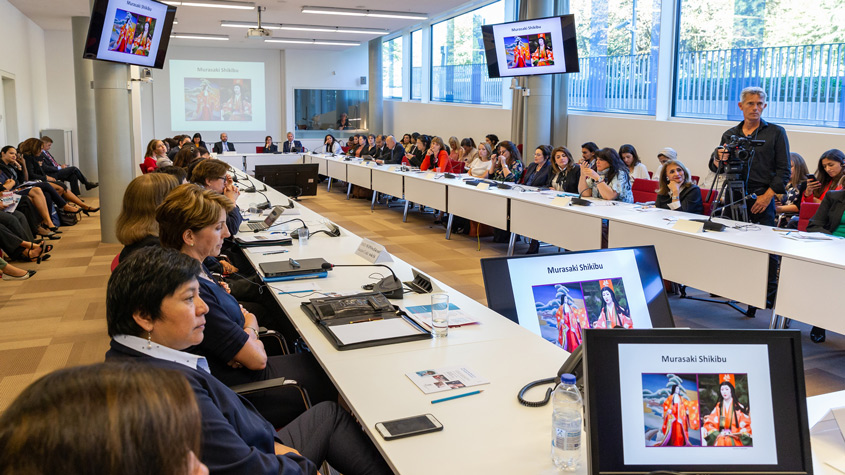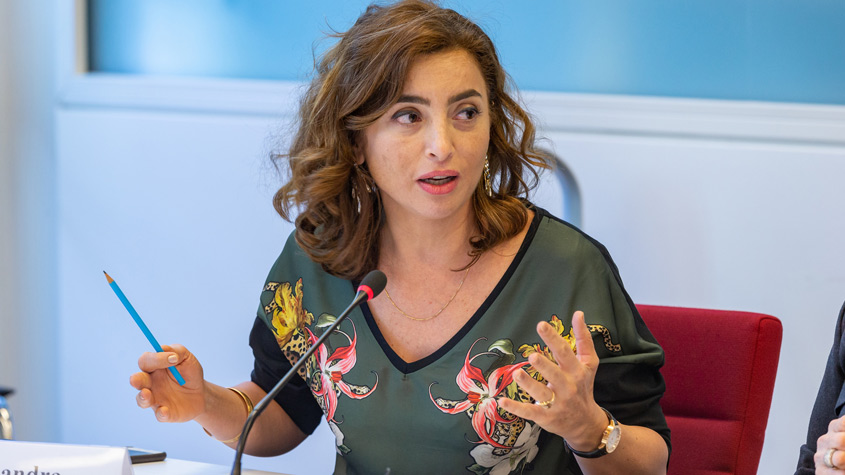WIPO Assemblies Side-Event on “Empowering Women in the Creative Industries” Draws Large Attendance
September 28, 2018
It was standing room only at a side event on the margins of the WIPO Assemblies organized by WIPO’s Human Resources Management Department and the Copyright and Creative Industries Sector on “Empowering Women in the Creative Industries” which highlighted gender inequalities in the creative industries and offered thoughts on remedies.
Video highlights Video (watch on YouTube)

WIPO commitment to gender equality
In opening remarks, WIPO Director General Francis Gurry underlined WIPO’s commitment to gender equality. While it is the 4th panel on gender equality and intellectual property that WIPO organizes during the Assemblies, it is the first one that focuses on the creative industries. The Director General pointed out the challenges in measuring the participation of women in the creative industries, in particular, in instances where copyright arises upon creation and without any registration.
Mr. Gurry said it is nevertheless clear that long-standing difficulties exist for women in the creative industries due to gender biases. He cited a historic example of the English novelist and one of the leading writers of the Victorian era, Mary Anne Evans, who wrote under the pen name George Eliot.
Views from the panel
The moderator, Ms. Karyn Temple, Acting Register of the U.S. Copyright Office, said women are responsible for some of the world’s most incredible and lasting creative contributions, but unfortunately, the numbers show that there are still many obstacles facing women in the creative industries. For instance, Ms. Temple shared that just 7 percent of the world’s film directors and 20 percent of screenwriters are female. And she mentioned that we are fortunate today to have one of those female film directors on the panel, Ms. Sandra Nashaat from Egypt.

Ms. Sandra Nashaat, a renowned film director from Egypt, pursued her dream of becoming a film director in spite of her father’s reservations. Asked what advice she would give to young women, she suggested they concentrate on their work and pursue their passion. She also stressed that women have to become well acquainted with their rights are and believe in themselves. Education, therefore, is critical.
Another panellist, Mr. Claudio Ossa, Head of the Chilean Copyright Office (Departamento de Derechos Intelectuales) recently conducted an analysis of the works registered by women in Chile between 1886 and 1925, revealing clear increasing trends despite large gender gaps. His office also conducted a campaign using three cartoon girl characters and three famous women in Chile in the creative industries - Gabriela Mistral, Marcela Paz and Violeta Parra. The strategy was to provoke discussion among the public by asking, if these three women could register their works with all the obstacles at their time, why can’t you?
Mr. Ossa showed that the percentage of the women who register their works had increased since the campaign kicked off, while the percentage of men remained stable or even decreased a little, thereby narrowing the gap significantly. While the campaign is not the only factor in narrowing the gap, it certainly contributed.
WIPO Deputy Director General Ms. Sylvie Forbin dedicated her talk to historically famous women in the creative industries, spanning from 10th century Japan to contemporary U.S., from literature to music to painting. Examples included women who had to use male names to publish their literary works and female composers and painters who created in the shadow of their male family members. She highlighted the gender biases that are still present today, but showed examples of talented women in the creative industries who found success, despite difficulties.
Audience shares views
A lively discussion session followed presentations by the panellists. Indonesia’s delegate shared examples in empowering women in the creative industries. The Indonesian Government has conducted a survey on the creative industries that showed that 55% of those in the industries are women. The Government is targeting mothers working in their homes to learn computer programming as “Coding Moms”. Peru’s Intellectual Property Agency (Indecopi) shared that they became the first public entity to sign the Gender Parity Agreement named “Somos Pares (We are equal)” and won an award on gender parity in the public sector category in 2018.
In conclusion, it became clear that while policies and words on paper are important, concrete actions are needed in order for change to happen. The panellists encouraged more and continuous work to ensure equality in the creative industries, working with the young generation, and supporting women to overcome their fears. The moderator suggested a two-pronged approach – artists and government working together, such as the Time-Up movement in the U.S. The responsibilities for change rest with all of us, be it as government officials, as parents, or as men and women.